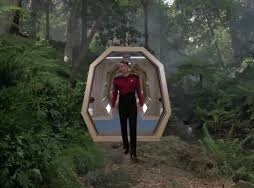
Arquivo para a ‘Visão artificial’ Categoria
Rede transforma texto datilografado em manuscrito
Um novo programa de computador desenvolvido 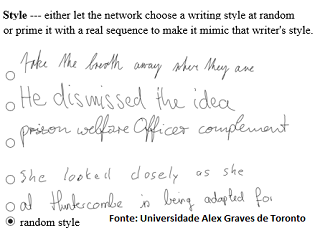 pela Universidade Alex Graves de Toronto de desenvolveu um programa usando redes neurais recorrentes (RNNs) para converter textos digitados em tipo de escrita “orgânicos” isto é, praticamente reais.
pela Universidade Alex Graves de Toronto de desenvolveu um programa usando redes neurais recorrentes (RNNs) para converter textos digitados em tipo de escrita “orgânicos” isto é, praticamente reais.
O programa permite que usuário configure para moldar tanto legibilidade como o estilo de manuscrito que seja parecido ao de determinada pessoa ou a ser tipo de caligrafia, conforme artigo da revista Techlÿ.
O programa de Toronto embora gere longas RNNs de memórias similares de curto prazo combinando com pontos de dados individuais em sequências complexas baseadas em previsões de probabilidade.
Muitas redes neurais que dependem de aprendizagem, nome dado para o “treinamento” das redes neurais, para produzirem os mesmos padrões de resultados depois de uma escolha ou seqüência de escolhas, que torne o processo de aprendizagem como bem-sucedido.
Embora seja raro que as RNNs gerem uma mesma solução mais do que uma vez, pois seriam necessário uma grande padronizada de dados tanto sistema complexos de entrada como na saída de dados complexa e deveriam produzir resultados ponto-por-ponto.
Isto indique que o modelo de Toronto são RNNs ssuperiores a outros modelos de inteligência artificial, como por exemplo é o caso de sistema de RNN é mais capazes de modelagem de dados multivariados.
Isto porque as amostras RNN de sua própria saída, alimentação cada ponto de dados de volta para o algoritmo como uma nova entrada, os resultados são bem próximos a escritas reais.
O artigo já está submetido ao repositório ArXiv.
Poderá a internet ser emocional ?
Segundo o site TechRunch isto não é um conceito 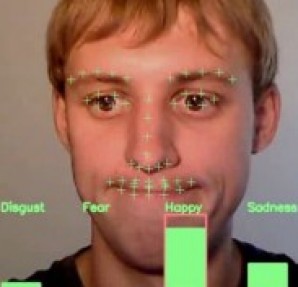 teórico, mas já há esforços para medir e quantificar a emoção humana de forma que a máquina possa compreender.
teórico, mas já há esforços para medir e quantificar a emoção humana de forma que a máquina possa compreender.
Três empresas já trabalham nisto, a Affectiva, uma empresa de medição de tecnologia de emoção, que coletou mais de um milhão de quadros com expressões faciais espontâneas, o VIBE, um software de visualização e interação da divisão de entretenimento da Microsoft Research, que emprega sensores para discernir humores via Bluetooth, e a Spire, que fabrica um pequeno sensores em forma de pedra que pode ser colocado em algum acessório do corpo humano, que pode medir o stress.
A maioria destas investigações e desenvolvimento são parte dos campos emergentes da computação afetiva, que examina maneiras de criar sensores e computadores que podem detectar e responder a emoções humanas.
Os estudos investigam padrões de fala, expressões faciais, gestos corporais e reações fisiológicas a estímulos específicos, mas será necessário acumular uma grande base de dados de emoções que pode treinar computadores para reconhecer e interagir de acordo com estímulos, uma vez que as pessoas podem reagir de modo diferente a um estímulo.
BBC develops remote control with the mind
Em parceria com a empresa This Place, a divisão de projetos digitais da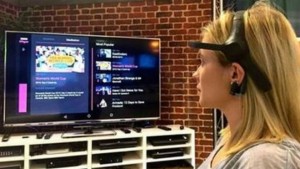 BBC desenvolveu em conexão com os conteúdos uma plataforma chamada iPlayer, a partir da qual pode-se quais programas assistir por meio de um aparelho que lê ondas cerebrais do espectador. Segundo Cyrus Saihan, chefe de desenvolvimento de negócios da divisão digital, em entrevista divulgada no site da BBC, o primeiro teste foi feito com dez funcionários da BBC e conseguiram usar e acionar o iPlayer, iniciando a transmissãod e um programa da TV. Saihan explicou, conforme o site, que este tipo de tecnologia poderá ser usada por pessoas com tenham algum tipo de deficiência que impeçam de usar o controle remoto. Ainda segundo ele, o o protótipo foi “feito para dar a quem faz nossa programação, nossos especialistas em tecnologia e outros usuários uma ideia de como isso poderá ser usado no futuro”, disse em entrevista ao site.
BBC desenvolveu em conexão com os conteúdos uma plataforma chamada iPlayer, a partir da qual pode-se quais programas assistir por meio de um aparelho que lê ondas cerebrais do espectador. Segundo Cyrus Saihan, chefe de desenvolvimento de negócios da divisão digital, em entrevista divulgada no site da BBC, o primeiro teste foi feito com dez funcionários da BBC e conseguiram usar e acionar o iPlayer, iniciando a transmissãod e um programa da TV. Saihan explicou, conforme o site, que este tipo de tecnologia poderá ser usada por pessoas com tenham algum tipo de deficiência que impeçam de usar o controle remoto. Ainda segundo ele, o o protótipo foi “feito para dar a quem faz nossa programação, nossos especialistas em tecnologia e outros usuários uma ideia de como isso poderá ser usado no futuro”, disse em entrevista ao site.
In partnership with the company this place, the digital arm of BBC projects developed in connection with the contents of a platform called iPlayer, from which one can watch what programs through a device that reads brain waves of the spectator.
According to Cyrus Saihan, head of development of the digital divide business, in an interview published on the BBC website, the first test was made with ten employees of the BBC and were able to use and press the iPlayer, starting transmissãod and a TV program.
Saihan explained, according to the site, that this type of technology could be used by people with have a disability that prevents them from using the remote control.
Also according to him, the the prototype was “made to give those who make our programming, our technology experts and other users an idea of how it can be used in the future,” he said in its interview.
Everyday scenes in 4D
Professor of Computer Science Noah Snavely, from Cornell University and his student Kevin Matzen have added a fourth dimension of time to your system called Scene Chronology, and have collected millions of images from photo sharing sites on the Internet and views from popular sites taken from several different angles created from 3-D models combined, and the Cornell News site.
of time to your system called Scene Chronology, and have collected millions of images from photo sharing sites on the Internet and views from popular sites taken from several different angles created from 3-D models combined, and the Cornell News site.
The models that have been developed to Times Square, the shopping district Akhibahara in Tokyo and 5Pointz a graffiti exhibition area in Queens, then a viewer can navigate within a virtual 3-D space while using a slider to move forward and backward in time and viewing reality in various positions.
The software works with flat surfaces in the image: signs, walls, façades or panels theater and then treats as “patches” which are stitched together to create the overall scene, the 3D effect, so it is made from a flat stage and need not be shot in 3D original, facilitating the shooting and the size of the files.
The 3-D model is then created from the global scene at a particular moment in time, the computer joins the slices that are taken from each solid in the right time and reconstructs the image for each time more simple and functional way.
The researchers who presented the model at the fair in Zurich Computer Vision, said: “when we reflect on the time of image collections, each observation has something to say,” they received the award for Best Book in the area last year.
They figure that may also change the way we think about photography, they said, and some day all photo you thought about doing, may have been made by someone.
Environment of total immersion
As researchers of Advanced Micro Devices claim, a version of a holodeck that is shaped like a dome, covered with wall-to-wall projectors, and uses surround sound, increased reality, and other Technologies are ready to recreate the real world.
The US Army Research Laboratory has created a floor, called an omnidirectional treadmill, which enables users to seemingly wander while it moves and while they stay in place.
Holodecks similar to the simulated-reality rooms seen on the film “Star Trek” but only will be available by 2024, according to these researchers, says a report in the New York Times blog.
Computer companies join with Hollywood and video-game factories want to turn something that is still only entertainment, into something closer to reality, by enabling users to see things and allow people to move around living rooms and become part of the story.
The technology can enable for example, those gamers in one stage, inside a game computer-simulated in the Yankee Stadium, to pick up a computer-simulated bat and hear the shouting of a computer-simulated crowd.
Microsoft has built the IllumiRoom and Lightspace, while the University of Illinois at Chicago has created CAVE2, this CAVE technologies are available and are well known.
The bionic man today
He already has human functions : walk, talk , and he has a beating heart (which can do exactly the function of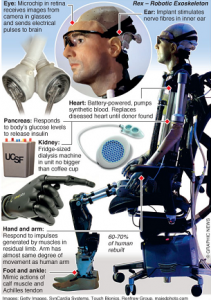 the human heart ) , but its purpose is not human , is to show the human functions made by technology, and that reason they are first totally bionic man in the world ( bionic man)
the human heart ) , but its purpose is not human , is to show the human functions made by technology, and that reason they are first totally bionic man in the world ( bionic man)
So he is ” a mixture of body parts , the bionic man is an amalgam of the most advanced human prostheses ,” as stated in the magazine LiveScience , ” the robotic limbs to artificial organs Circulatory System pumping blood ,” the floor and simulations take as perfect man .
The creature ” came to life ” in ” The Incredible Bionic Man ,” which premiered on Sunday ( October 20 ) at the Smithsonian Channel in a video (see the video of the Bionic Man) .
The devices used in the different organs were developed by different laboratories , such as the eye and the heart, such as prostheses that can be implanted in humans.
Still just merely a machine , without any kind of sense , the fiction of man is six million dollars , or Bicentennial Man , are still in the cinema .
He already has human functions : walk, talk , and he has a beating heart (which can do exactly the function of the human heart ) , but its purpose is not human , is to show the human functions made by technology, and that reason they are first totally bionic man in the world ( bionic man) .
So he is ” a mixture of body parts , the bionic man is an amalgam of the most advanced human prostheses ,” as stated in the magazine LiveScience , ” the robotic limbs to artificial organs Circulatory System pumping blood ,” the floor and simulations take as perfect man .
http://www.livescience.com/40535-show-unveils-worlds-first-bionic-man.html
The creature ” came to life ” in ” The Incredible Bionic Man ,” which premiered on Sunday ( October 20 ) at the Smithsonian Channel in a video (see the video of the Bionic Man) .
The devices used in the different organs were developed by different laboratories , such as the eye and the heart, such as prostheses that can be implanted in humans.
Yet it is only a machine , without any kind of feeling , the fiction of Man of the six million dollars , or Bicentennial Man , are still in the cinema.
Cego é homenageado como leitor assíduo
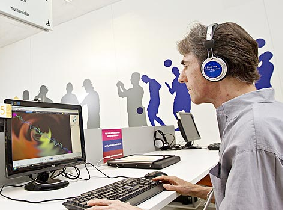 Segundo reportagem da Folha de São Paulo, Sérgio Florindo, 52,que é cego de nascimento é um dos leitores mais assíduos da Biblioteca de São Paulo, já lei em dois anos quase metade da coleção de 1.189 audiobook disponíveis na Biblioteca de São Paulo
Segundo reportagem da Folha de São Paulo, Sérgio Florindo, 52,que é cego de nascimento é um dos leitores mais assíduos da Biblioteca de São Paulo, já lei em dois anos quase metade da coleção de 1.189 audiobook disponíveis na Biblioteca de São Paulo
Segundo a reportagem, ele não lê em braile: “Não aprendi braile na infância. Tinha vergonha de ser cego e escondia isso. Amigos ajudavam emprestando seus olhos e liam para mim”, segundo a reportagem ele é aposentado tendo trabalhado no estoque de perfurmaria, conforme a reportagem.
O primeiro livro ele leu, foi trabalhador de estoque de perfumaria mas está aposentado, foi “A Morte e a Morte de Quintas Berro D’Água”, de Jorge Amado, claro em audiobook.
Foram amigos que fazia a leitura voluntária e um amigo foi “Um grande companheiro leu tudo para mim. Foi emocionante e me apaixonei por literatura. Mas, na vida adulta, foi ficando complicando achar voluntários”, lembra.
Pela segunda vez ele foi homenageado pela Biblioteca de São Paulo, como um dos frequentadores mais assíduos.


